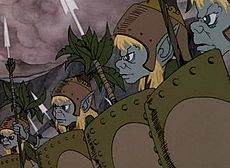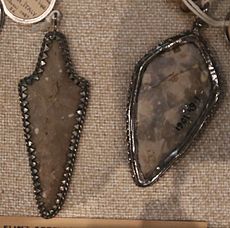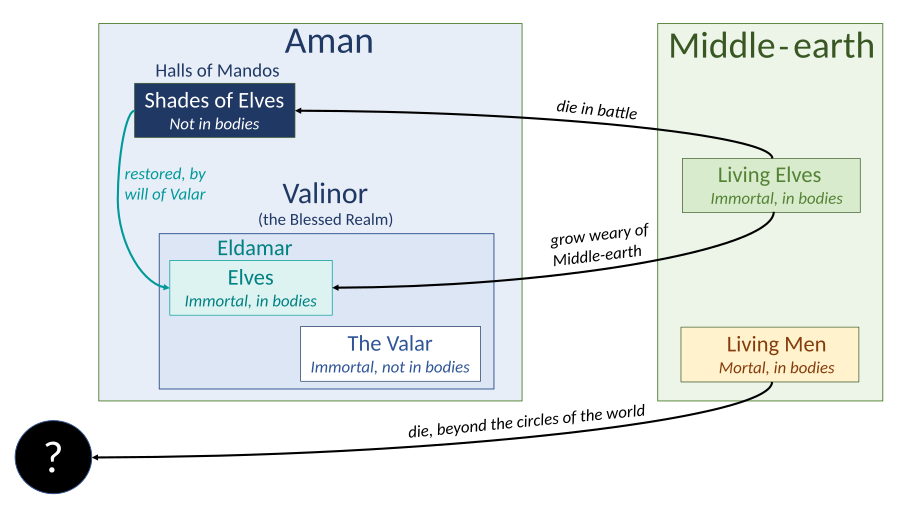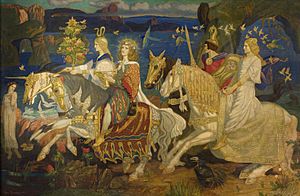Elves in Middle-earth facts for kids
In J. R. R. Tolkien's stories, Elves are a special group of people who live in Middle-earth. They were the first race to appear there. Unlike Men and Dwarves, Elves live forever. They are immortal, which means they don't die of old age. However, they can be killed in fights. If an Elf dies, their spirit goes to the Halls of Mandos in a place called Aman.
After living a very long time in Middle-earth, Elves often wish to go to a beautiful land called Valinor. They can sail there from the Grey Havens. Elves are important characters in The Hobbit and The Lord of the Rings. Their long history is told in The Silmarillion.
Tolkien got his ideas for Elves from old poems and languages in Northern Europe. These old stories made him think of Elves as tall, beautiful, and sometimes dangerous beings. They lived in wild places and were skilled with bows and arrows. Tolkien even created special languages for them, like Sindarin and Quenya. Today, Elves like Tolkien's are very common in fantasy books, movies, and games.
Contents
What Are Elves Like?
Where Did Tolkien Get the Idea?
The word Elf comes from an old English word, ælf. This word is found in many old Germanic languages. In ancient stories, there were many kinds of elves. Tolkien said his Elves were different from the ones in old Scandinavian stories.
Tolkien was a expert in old languages. He knew many old stories about elves. Some old texts described them as strong and dangerous. Others said they were beautiful. For example, an old poem called Beowulf mentioned "ogres and elves and devil-corpses." This shows that elves were seen as powerful and not always friendly.
Another old story mentioned an "elvish man" who was very strange. Some old medical texts even talked about "elf-shot," which was a mysterious illness. This made Tolkien think of Elves as skilled archers. People also used to say someone was "fair as an elf-woman" or "elf-beautiful" to describe great beauty.
Tolkien used all these different ideas to create his Elves. He made them beautiful but also dangerous. He connected them strongly to nature, like "wood-elves" and "water-elves." He also used the idea that time could feel different in Elf lands, like in his forest of Lothlórien. Tolkien combined all these old ideas to make his Elves feel very real and deep.

How Tolkien's Elves Changed Over Time
Tolkien's ideas about Elves grew and changed over many years.
Early Ideas (1915)
In his first poems, Tolkien's Elves were sometimes like the small, dancing fairies seen in Victorian paintings. He was inspired by plays like Peter Pan.
O! I hear the tiny horns
Of enchanted leprechauns
And the padded feet of many gnomes a-coming!—J. R. R. Tolkien, Goblin Feet, 1915
The Book of Lost Tales (1917–1927)
In his early stories, Tolkien imagined that Elves were once a great and powerful people. But as Men became more common, the Elves seemed to "shrink" or become less important. This idea came from old Norse myths and medieval stories.
Tolkien's Elves were also inspired by his own Catholic faith. He saw them as being like humans in the Garden of Eden before they made mistakes. They were more beautiful and wise, with stronger senses and a closer connection to nature. Tolkien wrote that Elves are "made by man in his own image... but freed from those limitations." This means they are like perfect humans.
The Hobbit (1930–1937)
In The Hobbit, Tolkien showed two types of Elves. There were serious, wise Elves like Elrond and the wood-elf king, Thranduil. But there were also more playful Elves, like the guards at Rivendell.
The Lord of the Rings (1937–1949)
In The Lord of the Rings, Tolkien often wrote as if he was just translating old stories. He said that the English names and words for Elves were his translations from their own language.
The idea of Elves "fading" or becoming less powerful also appears in The Lord of the Rings. The Elf-queen Galadriel says that if the Elves succeed in their fight against evil, their power will lessen. They would then have to leave Middle-earth or become like simple "rustic folk."
Tolkien also said that the Elvish language Sindarin sounded a lot like Welsh. He felt this fit the "Celtic" type of stories told about the Elves. He also explained that his Elves were not like the small fairies of Europe. Instead, they were like humans but with more artistic skill, beauty, and longer lives. In his stories, having Elf blood was a sign of nobility for Men.
Fictional History of Elves
The Awakening
The very first Elves were awakened by Eru Ilúvatar (the creator) near a bay called Cuiviénen. This happened long before the Sun and Moon were made, so they awoke under the stars. The first Elves were three pairs, and they found other Elves, who became their families. They lived by rivers and created poetry and music.
Later, a powerful being called Oromë found them. He brought the news of the Elves to Valinor, a land far to the west.
The Great Journey (Sundering)
The Valar (powerful beings like gods) wanted the Elves to come to Valinor. So, Oromë invited them. Many Elves agreed to take a long journey to the west, called the Great Journey. These Elves were called the Eldar, meaning "People of the Stars." Those who refused to go were called the Avari, "The Unwilling."
The Eldar were led by three Elf-lords: Ingwë, Finwë, and Elwë. They became the leaders of three groups: the Vanyar, the Noldor, and the Teleri.
- The Vanyar and Noldor traveled all the way to Valinor.
- Some of the Teleri were afraid of the mountains and turned back. They became the Nandor.
- Elwë, one of the Teleri leaders, got lost during the journey. Many Teleri stayed behind looking for him. These Elves later became known as the Sindar.
- The rest of the Teleri eventually made it to Valinor.
This splitting of the Elves into different groups is called the Sundering of the Elves. It allowed Tolkien to create different Elvish languages, like Quenya for the Elves in Valinor and Sindarin for the Sindar in Middle-earth.
Exile of the Noldor
In Valinor, the greatest Elf, Fëanor, created beautiful jewels called the Silmarils. They held the light of the Two Trees of Valinor. But a dark Vala named Melkor (later called Morgoth) stole the Silmarils and killed Fëanor's father.
Fëanor and his seven sons swore a terrible oath to get the Silmarils back. They led a large army of the Noldor Elves back to Middle-earth, leaving Valinor. This was a sad and difficult time for the Elves.
Wars in Beleriand
In Middle-earth, Elwë, who had been lost, became King Thingol of the Sindar Elves. The Noldor Elves arrived and fought many wars against Morgoth. They tried to defeat him, but Morgoth was very powerful. Over time, the Elves lost many of their hidden kingdoms.
Finally, a half-elf named Eärendil the Mariner sailed to Valinor to ask the Valar for help. The Valar then fought a great war against Morgoth, called the War of Wrath, and defeated him.
Later Ages
After Morgoth's defeat, many Elves returned to Valinor. But some stayed in Middle-earth. During the Second Age and Third Age, they built new kingdoms like Lindon, Eregion, and Rhovanion (Mirkwood).
Sauron, Morgoth's old servant, became a new enemy. The Elves fought him, often with the help of Men. The Elves also had three powerful magic rings, which helped them protect their lands like Lothlórien, Rivendell, and the Grey Havens.
The Fourth Age
After the evil One Ring was destroyed, the power of the Elves' rings ended. The Fourth Age, the Age of Men, began. Most Elves left Middle-earth for Valinor. Those who stayed slowly faded away. They became less visible to mortals and eventually became like the "rustic folk" of old stories.
Some Elves, like Legolas, stayed for a while and helped rebuild lands like Gondor. But eventually, almost all Elves left Middle-earth for good.
Elvish Life and Skills
Marriage and Family
Elves have a long pregnancy, about a year. By age one, they can speak, walk, and dance. They reach their full height and maturity around 50 to 100 years old. Elves marry for love, usually only once. Their engagement lasts at least a year. The wedding is a simple promise between the bride and groom. Elves have few children, and there are long breaks between each child. They also enjoy arts and other hobbies.
Skills and Talents
Elves, especially the Noldor, are very skilled in crafts. They are great at smithwork, sculpture, music, and other arts. Both male and female Elves are equal. Females often focus on healing, while males go to war. However, both can defend themselves, and many males are also skilled healers. Elves are also excellent horse-riders.
Elvish Languages
Tolkien created many languages for his Elves. He said his stories grew out of these languages. The most complete are Quenya (High-elven) and Sindarin (Grey-elven). Elves also invented their own writing systems, like the Tengwar and Cirth scripts.
Immortality and Death
Elves are immortal and do not get tired with age. They can heal from serious wounds that would kill a Man. But they can be killed in battle or by accident. If an Elf dies, their spirit goes to the Halls of Mandos in Valinor. After a time of rest, their spirits are given new bodies just like their old ones.
If Elves don't die in battle, they eventually grow tired of Middle-earth. They then wish to go to Valinor. They often sail from the Grey Havens, where Círdan the Shipwright lives. Over many thousands of years, their immortal spirits would eventually use up their bodies, making them "bodiless." At the end of the world, Elves will become invisible to mortal eyes, unless they choose to show themselves.
Elves in Movies

In Peter Jackson's Lord of the Rings movies (2001–2003), Elves are shown as physically stronger and better than Men. They have amazing eyesight, balance, and aim.
Some experts say that Jackson's Elves look more like the romanticized "Celtic" fairies from the 19th and 20th centuries. For example, the scene where Elves ride through the Shire looks similar to a 1911 painting called The Riders of the Sidhe. Tolkien's own Elves were based more on older English and Norse traditions.
Images for kids
-
Arda in the First Age, showing the sundering of the Elves. Elves awoke at Cuiviénen (right) and many traveled west to Valinor in Aman. Some stopped in Beleriand (top).
See also
 In Spanish: Elfos (Tolkien) para niños
In Spanish: Elfos (Tolkien) para niños





